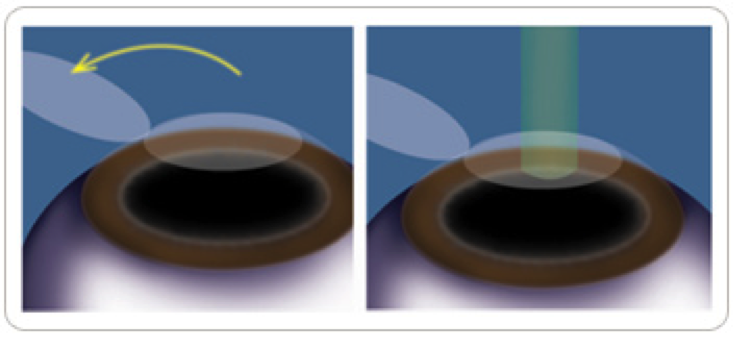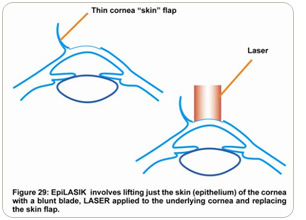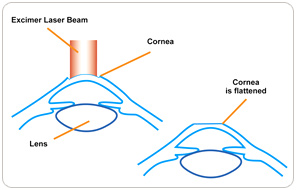Overview
With our Allegretto Wave by Wavelight laser technology, EEC now has the capabilities to do a true ‘No Touch / All laser / No Flap’ laser vision correction procedure, called Trans-Epithelial Surface Treatment
This technique doesn’t involve any equipments or machines touching the cornea. The cornea is a transparent curved lens at the front of the eye. With a new devised algorithm, the technique makes use of the excimer laser to ablate the epithelium (top skin layer of the corneal) and subsequently the additional laser ablation to reshape the cornea to correct the degree.
“No Touch All-Laser Epi-LASIK” can be used with the full range of customised laser eye surgery treatment options offered by the Allegretto Wave by Wavelight laser including wavefront optimised/guided or topography guided, depending on the needs of each patient.
What you need to know
Refractive surgery by use of laser correction is performed in one of two ways

1) Creation of a flap (by means of a blade mechanism called the microkeratome or a laser called femtosecond laser) on the cornea prior to using the excimer laser to re-shaping the cornea – otherwise known as LASIK or IntraLASIK or

2) Removal of the surface layer of the cornea (epithelium) before using the excimer laser to re-shape the cornea – otherwise known as PRK, LASEK, EPI-LASIK
No Touch All-Laser Epi-LASIK is an advanced form of laser correction treatment
The procedure is performed in two stages:
Firstly, an excimer laser is used to ablate away the surface layer (epithelium) of the cornea with pinpoint accuracy and regularity. Research on the Allegretto Wave has found that this laser platform can very accurately define the transition as the laser goes through the epithelium by direct visualisation in low ambient light, so we can exactly limit the ablation to within 1 micron (thereby minimising possible stromal tissue loss). Secondly, the excimer laser is then programmed to ablate exactly the effective amount of corneal stromal tissue required to re-shape the cornea to improve one’s vision. Following treatment a bandage contact lens is placed over the cornea for a few days as the epithelial layer heals.
What Are The Advantages?
Advantages of “No Touch All-Laser Epi-LASIK” over LASIK/IntraLASIK:
- Unlike LASIK, where a patient’s eye has to be ‘held on’ to during the creation of a flap, the “No Touch All-Laser Epi-LASIK” does not require holding onto the eye and creating a flap, making the overall treatment more comfortable for the patient.
- Unlike LASIK where there is a flap created, there is no flap created for “No Touch All-Laser Epi-LASIK”, thus the procedure is less invasive and it removes ALL risk/potential for any flap-related (short or long term) complications during treatment.
- There is also less risk of long-term corneal biomechanical instability.
Advantages of “No Touch All-Laser Epi-LASIK” over PRK/LASEK/Epi-LASIK:
- Unlike LASEK/Epi-LASIK where alcohol or a mechanical separation of epithelial layer occurs, the removal of the epithelium for “No Touch All-Laser Epi-LASIK” is done with the use of a programmed excimer laser platform. This enables higher accuracy in the amount of corneal tissue removed, avoids poor quality epithelial flaps and alcohol toxicity. Furthermore, with the“No Touch All-Laser Epi-LASIK”, the procedure does not require any suction of the eye during the treatment.
- Clinical studies on animals have shown that quicker healing (re-epithelialisation) occurs following treatment in comparison mechanical separation of epithelial layers. And as a result, patients will experience less pain and faster vision stabilisation compared to LASEK/Epi-LASIK.
Disadvantages of “No Touch All-Laser Epi-LASIK”:
- Unlike LASIK, where patients usually experience pain-free recovery, patients who undergo the“No Touch All-Laser Epi-LASIK” can expect to experience pain or discomfort for 1-2 days following treatment. However, according to the clinical studies on animals, the amount and duration of the discomfort is still less and shorter in comparison to LASEK/Epi-LASIK.
- Unlike LASIK where patients usually achieve good functional vision by the next day after surgery, patients who undergo the “No Touch All-Laser Epi-LASIK” can expect for visual recovery to take longer (about 1-3 weeks for functional vision). However, in comparison to Epi-LASIK, the recovery is still shorter.
- Compared to LASIK, there is a small risk of corneal haze for patients who undergo “No Touch All-Laser Epi-LASIK”, but again when compared to Epi-LASIK, the risk is lower.
For which patients would EEC recommend the “No Touch All-Laser Epi-LASIK”?
- For patients under circumstances where his/her corneal bio-mechanics may be compromised beyond clinically acceptable limits for long term safety. This would depend on the complexity of the patient’s corneal shape, thickness, prescription being considered for treatment and many other related issues.
- For patients appears to fall into a category of increased possibility of LASIK flap complications e.g. small, deep set eyes.
- For patients who actively participate in contact sports e.g. rugby, soccer, martial arts etc. or engage in activities with enhanced risk of injuries e.g. firemen, police or armed forces personnel, etc.
- For patients who are highly anxious or having a particular phobia about flap creation.
- For some re-treatment (enhancement procedures) of patients who have had previous corneal surgery.
- For preparation of the under layer of the cornea for Keratoconic patients who are about to undergo corneal cross-linking
Find out more FAQ’s About Lasik by following this link.
Eagle Eye Centre will evaluate and determine which procedure is best for you. We will inform you of the benefits and risks of each procedure, and answer all of your questions regarding the procedures.
If you’re interested in EPI-LASIK, schedule a consultation to determine if you are a good candidate for EPI-LASIK, LASIK, or another refractive surgery treatment.


